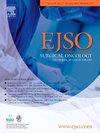甘露糖标记的磁性纳米颗粒用于口腔鳞状细胞癌前哨淋巴结活检:一项1期临床试验的初步结果
IF 3.5
2区 医学
Q2 ONCOLOGY
引用次数: 0
摘要
前哨淋巴结活检(SLNB)可以分期口腔鳞状细胞癌(OSCC)的颈部疾病,其发病率低于选择性颈部清扫(END),但由于传统放射性示踪剂的固有局限性,未被广泛应用。本研究评估了下一代磁性技术的可行性。材料与方法进行1期前瞻性临床试验,招募cN0型OSCC患者。“FerroTrace”,一种甘露糖标记的氧化铁纳米颗粒,被注射到肿瘤周围。在手持式磁强计探针的辅助下,患者在SLNB前接受了伪动态和静态序列的MRI检查。sln被送往连续切片,患者在与标准护理相同的程序中接受了END。结果8例患者T2病变位于舌部(4/8)、磨牙后三角区(3/8)和口腔底(1/8)。术中通过磁强计探头平均发现4.1±1.5 (n = 33)个磁ln,包括术前MRI发现的sln(2.6±1.4;n = 21)。作为标准护理END的一部分,每位患者额外切除24.6±10.5 (n = 197)个LNs。一个磁性LN被确认为pN+,其余所有磁性和END LN均为pN0。无不良事件记录。结论本研究证明了一种新的磁性方法在OSCC中使用首次在人体中使用的磁性示踪剂进行SLNB的程序可行性。这些有希望的早期结果为有吸引力的下一代技术奠定了基础,并具有在复杂的头颈部淋巴环境中增加SLNB采用的巨大潜力。本文章由计算机程序翻译,如有差异,请以英文原文为准。
Mannose-labelled magnetic nanoparticles for sentinel lymph node biopsy in oral squamous cell carcinoma: Initial results from a phase 1 clinical trial
Introduction
Sentinel lymph node biopsy (SLNB) can stage neck disease in oral squamous cell carcinoma (OSCC) with less morbidity than elective neck dissection (END) but is not widely practised because of inherent limitations associated with conventional radiotracers. This study evaluated the feasibility of a next generation magnetic technique.
Materials and methods
A phase 1 prospective clinical trial was conducted, recruiting patients with cN0 OSCC. “FerroTrace”, a mannose-labelled iron oxide nanoparticle, was injected peritumourally. Patients underwent MRI with pseudo-dynamic and static sequences prior to SLNB aided by handheld magnetometer probe. SLNs were sent for serial-sectioning and patients underwent END in the same procedure as standard of care.
Results
Eight patients were enrolled with T2 lesions located in the tongue (4/8), retromolar trigone (3/8) or floor of mouth (1/8). An average of 4.1 ± 1.5 (n = 33) magnetic LNs per patient were identified via magnetometer probe during surgery, which included SLNs identified on preoperative MRI (2.6 ± 1.4; n = 21). An additional 24.6 ± 10.5 (n = 197) LNs per patient were removed as part of standard of care END. One magnetic LN was confirmed pN+, with all remaining magnetic and END LNs pN0. No adverse events were recorded.
Conclusion
This study demonstrates the procedural feasibility of a novel magnetic approach to SLNB in OSCC using a first-in-human magnetic tracer. These promising early results lay the foundation for an attractive next generation technique, and holds significant potential to increase adoption of SLNB in the complex head and neck lymphatic environment.
求助全文
通过发布文献求助,成功后即可免费获取论文全文。
去求助
来源期刊

Ejso
医学-外科
CiteScore
6.40
自引率
2.60%
发文量
1148
审稿时长
41 days
期刊介绍:
JSO - European Journal of Surgical Oncology ("the Journal of Cancer Surgery") is the Official Journal of the European Society of Surgical Oncology and BASO ~ the Association for Cancer Surgery.
The EJSO aims to advance surgical oncology research and practice through the publication of original research articles, review articles, editorials, debates and correspondence.
 求助内容:
求助内容: 应助结果提醒方式:
应助结果提醒方式:


